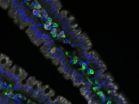(Press-News.org) His design has earnt a spot on the first-round shortlist of one of the world's most prestigious design competitions - the Australian Design Award/James Dyson Award.
Twenty-four-year-old Ching-Hao (Howard) Hsu, who graduated with a Bachelor of Design (Industrial Design) at the end of 2010, designed the 'arthritis handle' after observing several sufferers of rheumatoid arthritis performing cooking tasks in their own kitchens.
RA is a chronic disease affecting one percent of the population - about 500,000 Australians. It involves inflammation of the joints, which can lead to stiffness, swelling and sometimes disablement in the hands.
"After several observations and lots of interviews, I found that lifting was a major problem for sufferers of RA during cooking preparation," Mr Hsu said.
"It was difficult for sufferers of RA to lift things with their hands, due to having limited strength and flexibility. So they had to lift with their forearms. This limited them to using cookware with handles on both sides.
"If a saucepan only had one handle, most people put a towel over their other forearm to grasp the opposite side of the pot, but this was a slippery and dangerous way of lifting, exposing the person to the risk of burns.
"The arthritis handle allows sufferers of RA to use any kind of cookware, and not be limited to double-handled products.
"Due to the limited flexibility of a hand with RA, the ergonomically-designed finger holder at the front of the arthritis handle fits comfortably on the user's hand without twisting the user's fingers.
"The shape of the arthritis handle is also ergonomic, in that it spreads the weight of the cookware across the user's forearm."
Mr Hsu said the arthritis handle featured a silicone coating with heat resistance up to 200 degrees celsius, to prevent heat from being directed to the forearm.
"The TPE (thermoplastic elastomers) used in the product provide grip, while a magnetic strip enhances the stability for people lifting metal cookware," he said.
"I want to make sure that the arthritis handle is eventually made available in various colours. People using assistive technologies often hate sticking out as being a 'special' person. So I want this to look like a normal kitchen tool, with the inner frame available in bright orange, yellow or green, with a white outer frame."
Mr Hsu, who grew up in Taiwan, began his masters in lighting engineering at QUT in February, and hopes to work on environmentally friendly products in the future.
INFORMATION:
Mr Hsu's entry in the ADA/James Dyson Award can be viewed at http://www.student.designawards.com.au/
The arthritis handle has also been entered in the Kitchen Tools International Design Competition.
You can watch a demonstration of the product on Youtube at http://www.youtube.com/watch?v=6aK5TDyA_wg
RA sufferers armed with kitchen safety tool
2011-03-08
ELSE PRESS RELEASES FROM THIS DATE:
Flipping a switch on neuron activity
2011-03-08
WASHINGTON, D.C. (March 7, 2011) -- All our daily activities, from driving to work to solving a crossword puzzle, depend on signals carried along the body's vast network of neurons. Propagation of these signals is, in turn, dependent on myriad small molecules within nerve cells -- receptors, ion channels, and transmitters -- turning on and off in complex cascades. Until recently, the study of these molecules in real time has not been possible, but researchers at the University of California at Berkeley and the University of Munich have attached light-sensing modules to ...
Body mass index and risk of death in Chinese population
2011-03-08
Chinese people with a body mass index (BMI) of 24-25.9 had the lowest risk of death, according to a study published in CMAJ (Canadian Medical Association Journal) (pre-embargo link only) http://www.cmaj.ca/embargo/cmaj101303.pdf
Obesity has increased significantly across the globe and the World Health Organization (WHO) estimates that about 2.3 billion adults will be overweight and more than 700 million will be obese by 2015. Overweight and obesity are associated with increased risks of heart disease, diabetes, cancer and other chronic diseases.
As white populations ...
Dementia risk is higher in people with both stroke and irregular heartbeat
2011-03-08
Stroke patients who also suffer from an irregular heartbeat are at double the risk of developing dementia, according to a new study by the University of East Anglia (UEA).
Published tomorrow in the journal Neurology, the findings show that stroke survivors with an irregular heartbeat – or atrial fibrillation - are 2.4 times more likely to develop dementia than stroke survivors without the heart condition.
The researchers analysed 15 studies with more than 45,000 participants and an average age of 72. They compared patients with and without atrial fibrillation, and ...
Stroke survivors with irregular heartbeat may have higher risk of dementia
2011-03-08
ST. PAUL, Minn. – Stroke survivors who have an irregular heartbeat called atrial fibrillation may be at higher risk of developing dementia than stroke survivors who do not have the heart condition, according to research published in the March 8, 2011, print issue of Neurology®, the medical journal of the American Academy of Neurology.
Atrial fibrillation affects more than two million Americans, and it is more common as people age. About 15 percent of strokes occur in people with atrial fibrillation. The heart's two upper chambers do not beat effectively in the condition, ...
Mediterranean diet: A heart-healthy plan for life
2011-03-08
The Mediterranean diet has proven beneficial effects not only regarding metabolic syndrome, but also on its individual components including waist circumference, HDL-cholesterol levels, triglycerides levels, blood pressure levels and glucose metabolism, according to a new study published in the March 15, 2011, issue of the Journal of the American College of Cardiology. The study is a meta-analysis, including results of 50 studies on the Mediterranean diet, with an overall studied population of about half a million subjects.
"The prevalence of the metabolic syndrome is ...
Diabetes belt identified in southern United States
2011-03-08
San Diego, CA, March 8, 2011 – In the 1960s, a group of U.S. states with high age-adjusted stroke mortality defined a "stroke belt." Until recently, geographic patterns of diabetes had not been specifically characterized in the same manner. In an article published in the April 2011 issue of the American Journal of Preventive Medicine, researchers were able to identify clustered high prevalence areas, or a "diabetes belt" of 644 counties in 15 mostly southeastern states using data compiled for the first time of estimates of the prevalence of diagnosed diabetes for every ...
How sweet it is: Why your taste cells love sugar so much
2011-03-08
PHILADELPHIA (March 7, 2011) – A new research study dramatically increases knowledge of how taste cells detect sugars, a key step in developing strategies to limit overconsumption. Scientists from the Monell Center and collaborators have discovered that taste cells have several additional sugar detectors other than the previously known sweet receptor.
"Detecting the sweetness of nutritive sugars is one of the most important tasks of our taste cells," said senior author Robert F. Margolskee, M.D., Ph.D., a molecular neurobiologist at Monell. "Many of us eat too much sugar ...
Researchers define a new type of secretory cell in the intestine
2011-03-08
The intestinal epithelium consists of four main specialized cell lineages: absorptive enterocytes and three secretory cell types known as enteroendocrine, Paneth, and goblet cells. But a rare, fifth type of intestinal cell called tuft cells also exists. Defined by the thick brush of long microvilli that project from their apical surface, tuft cells are seen in several epithelial tissues, yet little is known about their function due to a lack of tuft cell–specific markers.
In the March 7 issue of The Journal of Cell Biology (www.jcb.org), a team of French researchers ...
Parkinson's disease may be caused by microtubule, rather than mitochondrial complex I, dysfunction
2011-03-08
Patients with Parkinson's disease (PD) suffer a specific loss of dopaminergic neurons from the midbrain region that controls motor function. The exact mechanism of this selective neurodegeneration is unclear, though many lines of evidence point to dysfunctional mitochondrial complex I as one root cause of the disease. Yet new research now suggests that defective regulation of microtubules may be responsible for at least some cases of PD. The study appears in the March 7 issue of The Journal of Cell Biology (www.jcb.org).
Mitochondria were first implicated in PD when ...
Using a molecular switch to turn on cancer vaccines
2011-03-08
The immune system is capable of recognizing tumor growth, and naturally mounts an anti-cancer defense. Dendritic cells (DCs) can take up tumor-derived molecules (antigens) and present them to T cells, and those "primed" T cells are then able to recognize and kill tumor cells. In recent years, researchers have attempted to capitalize upon these natural immune responses to develop new therapies- namely, by generating a pool of tumor antigen-pulsed DCs that might be used as vaccines to augment the T-cell responses of cancer patients. In clinical trials, these DC vaccines have ...



